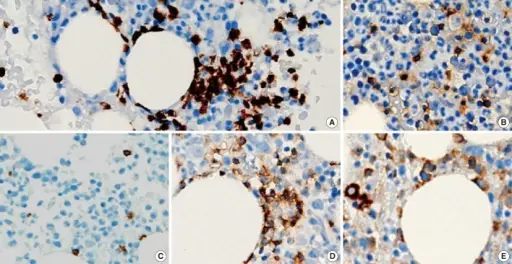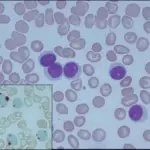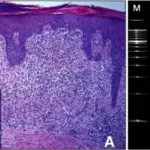Large granular lymphocytic leukemia is a chronic T cell lymphoproliferative disorder characterized by a clonal proliferation of mature cytotoxic T cells.
What is the Pathology of Large Granular Lymphocytic Leukemia?
The pathology of large granular lymphocytic leukemia is:
-Etiology: The cause of large granular lymphocytic leukemia is chronic antigen exposure from autoimmune disorders such as rheumatoid arthritis and Sjogren syndrome.
-Genes involved: None.
-Pathogenesis: The sequence of events that lead to large granular lymphocytic leukemia involve acquired mutations in the transcription factor STAT 3, which functions downstream of cytokine receptor. This result in cytokine-independent activation of STAT 3 which favors proliferation.
-Histology: The histology associated with large granular lymphocytic leukemia shows large lymphocytes with abundant blue cytoplas and a few coarse azurophilic granules. The marrow contains sparse interstitial lymphocytic infiltrate.
How does Large Granular Lymphocytic Leukemia Present?
Patients with large granular lymphocytic leukemia typically are elderly individuals with a median age range of 60 years and no gender predilection.
The symptoms, features, and clinical findings associated with large granular lymphocytic leukemia include mild to moderate lymphocytosis, splenomegaly, neutropenia, anemia, cytopenias and history of autoimmune disorders (e.g. rheumatoid arthritis). Neutropenia may be accompanied with a decrease in late myeloid forms.
How is Large Granular Lymphocytic Leukemia Diagnosed?
Large granular lymphocytic leukemia is diagnosed by peripheral blood smears showing persistent increase in the number of peripheral blood large granular lymphocytes. Molecular or flow cytometry may be helpful.
How is Large Granular Lymphocytic Leukemia Treated?
Large granular lymphocytic leukemia is treated with immunosuppressive therapy of methotrexate, cyclophosphamide as initial agents. Low dose chemotherapy may be used. No standard therapy is established.
What is the Prognosis of Large Granular Lymphocytic Leukemia?
The prognosis of large granular lymphocytic leukemia is variable due to its indolent course and being largely dependent on the severity of the cytopenias and responsiveness to treatment.




